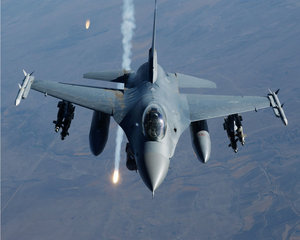Every child grows up with dreams and ambitions. Be they attend college, own a home, travel the world, be a CEO of a company or even become President of the . With determination, hard work, and guidance all of these goal and dreams are attainable. Hard work and determination are determined on a personal level, hopefully, for people who want to become an Air Force fighter pilot, I can help you with the guidance.
I am sad to stay that not every person who wants to be a fighter pilot can become one, at least not through the United States Air Force. There is an age limit requirement that states you must apply for training prior to being 28.5 years old and must be in training by your 30th birthday. As long as you meet these criteria, read on.
Step one – become an Air Force Officer. Every pilot in every aircraft that the military flies is either a commissioned officer or warrant officer [warrant officers fly helicopters and will not be discussed in this article]. To become an officer you need to receive a commission from one of three available commissioning sources. You can receive a commission through the Air Force Academy, Reserve Officer Training Corps (ROTC), or Officer Training School (OTS). Links to each of the commissioning sources can be found at the end of the article. In addition to receiving a commission you must also have a bachelor’s degree. While you can be working towards your degree while at the Air Force Academy or while participating in ROTC, you must posses a degree prior to applying to OTS.
Step two – receive a pilot slot from your commissioning source. This task is a bit more complicated and competitive than the first one. To make matters more complicated all three commissioning sources select their pilots using different criteria, standards, and processes. To simplify things, let look at each source individually.
The Air Force Academy: The Air Force Academy rank orders all of the cadets in each graduating class from number one to last. This rank order is based upon academic performance, military performance, and physical fitness. Academic performance, weighted at 50% towards your overall rank is by far the most important. So study up and keep that GPA in engineering high! Military performance is based on subjective measurements by your superiors on how well you lead, perform job duties, and accomplish job and class goals. Military performance is weighted 35%. This is by far the hardest to score well in since the rankings are subjective. However keeping a good attitude and good work ethic will help you in this area. Finally, physical fitness is weighted 15% of your overall ranking. Your physical fitness is measured quantitatively by the physical fitness test which consists of pushups, situps, 1.5 mile run and a waist tape measurement. The test is based on a 100 point scale with the 1.5 mile run worth 50% – so keep doing those early morning jogs! By the end of four years of school and training your overall ranking should reflect your actual standing as a cadet. During the middle of your senior year you fill out a dream sheet with what positions in the Air Force you would like to have and then find out later that year. Obviously those cadets with the higher rank order will receive their number one requests first.
Reserve Officer Training Corps: Receiving a pilot slot through ROTC is very similar to receiving one through the Air Force Academy, except with a few more variables. Just like the Air Force Academy you are rank ordered in your graduating class number one through last. That rank order is based off of commander’s ranking, GPA, physical fitness, Field Training results, and your Pilot Candidate Selection Method (PCSM) score. The most important is your commander’s ranking which is weighted 50%. This is a subjective ranking and is based on an overall picture of who you are as a cadet. Are you motivated? Do you volunteer? Do you show up on time? Do you stay late? Do you consistently provide results and perform well under pressure? If you answer yes to these questions then it will help your commander’s ranking. GPA is weighted 15% and should be self explanatory. Physical fitness is weighted 15% uses the same physical fitness test explained above that the Air Force Academy uses (which also happens to be the same test the active duty Air Force uses to measure overall physical fitness). Field Training results are unique to ROTC. The summer between your sophomore and junior year cadets are sent to a Field Training Unit at Tyndall AFB, Florida, Maxwell AFB, Alabama, or Ellsworth AFB, South Dakota for four weeks for an “officer type” boot camp. At these Field Training Units you are rank ordered within your individual flight (which usually consist of around 20 – 25 members) number one through last. There are usually 15 to 20 flights at each of these units. This rank is then sent back to your ROTC detachment and is weighted 15% of your overall rank. Finally, your PCSM score is weighted 10%. This score is a compilation of your Basic Aptitude Test (BAT Test), Air Force Officer Qualification Test (AFOQT), and any private flying hours you may already have. While going into detail about all these tests and scores would bore you, you can score highest in this category by preparing for the AFOQT by looking at study guides (point your browser here: http://www.baseops.net/afoqt/) and by having a few private flying hours. I know private flying hours can be expensive so you get the most “points” for dollar spent at around 11 private flying hours. Be aware, 11 hours can cost you upwards of $500 for plane rental, and instructor pilot fees, but may give you that edge to maximizing your PCSM score. In ROTC you submit your dream sheets halfway through your junior year and find out later in the year of your selection. Again, the cadets with the higher rankings will receive their top choices.
Officer Training School: Surprisingly different from either the Air Force Academy or ROTC, you apply for specific Air Force positions (pilot) in your overall application submission to OTS. Therefore if you apply to OTS asking to be a pilot and are accepted, you will be a pilot! The application process is a bit long and arduous for OTS. OTS commissions the least number of officers compared to the other two commissioning sources and can afford to be choosier about who they accept into the program. The application process consists of multiple interviews, a physical fitness test, your overall GPA in college, BAT test, and AFOQT. How much each of the tests and interviews a weighted is not disclosed. Essentially the same efforts that would make you successful in ROTC will more than likely help you in your application to OTS.
Step Three – Attend pilot training and track select to T-38s. Keep in mind that everything you have done up to this point was simply to get a spot to attend Air Force pilot training. You now need to graduate and excel at pilot training in order to become a fighter pilot. There are six different pilot training bases located throughout the country. They are at Vance AFB, Oklahoma, Laughlin AFB, Texas, Columbus AFB, Mississippi, Whiting Field, Florida, Moody AFB, and Sheppard AFB, Texas. Pilot training is around 55 weeks in length during which time your flying performance and personal preference dictate whether or not you will continue training in T-1 Jayhawks and go on to fly transport, cargo, and refueling aircraft or T-38 Talons and go on to fly bomber and fighter aircraft. Your flying performance ratings are mostly based on your performance during a few key rides called “check rides” in which your overall proficiency is evaluated.
Doing well on these check rides is vital to being able to fly receive your top choice on which type of aircraft you want to fly. And if you are reading this article, that type of aircraft is probably a fighter. Just don’t expect everything to be like “Top Gun”, it takes a bit of work to be successful. Good luck!



